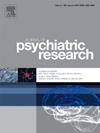Monocyte profiles and their association with depression severity and functional disability
IF 3.7
2区 医学
Q1 PSYCHIATRY
引用次数: 0
Abstract
Background
Inflammatory processes have been implicated in the pathophysiology of depression. This study explores the association between the number, proportion and subtypes of monocytes with functional disability and depression severity in a sample of adult patients.
Methods
A cross-sectional study was conducted with 74 participants. The total number and proportion of monocytes were obtained from hemogram analysis and the subtypes (classical, intermediate, and non-classical) were quantified using flow cytometry. Depression severity was assessed using the 17-item Hamilton Depression Rating Scale (HDRS-17), and functional disability was measured via the Sheehan Disability Scale (SDS). Linear regression models adjusted for demographic and clinical covariates were applied to evaluate associations.
Results
Total blood monocyte counts and their percentages were negatively correlated with functional disability scores (r = −0.27 and r = −0.26, respectively; p < 0.05). In contrast, elevated levels of intermediate and non-classical proinflammatory monocytes were positively correlated with depression severity (r = 0.25, p < 0.05). Linear regression analysis revealed that a 1% increase in proinflammatory monocytes was associated with a 0.19-point increase in HDRS-17 scores (p = 0.009). Additionally, higher total and percentage monocyte counts were associated with reductions in functional disability scores by 10.63 units (p = 0.02) and 0.80 units (p = 0.04), respectively.
Conclusion
Monocytes play a dual role, contributing to both the initiation and resolution of inflammation. In this study, we found that monocytes may be involved in protecting functional responses while also reflecting depression severity. These findings underscore the potential of monocyte profiles as biomarkers for depression severity and functional impairment, highlighting the need for further research to elucidate the underlying mechanisms.
求助全文
约1分钟内获得全文
求助全文
来源期刊

Journal of psychiatric research
医学-精神病学
CiteScore
7.30
自引率
2.10%
发文量
622
审稿时长
130 days
期刊介绍:
Founded in 1961 to report on the latest work in psychiatry and cognate disciplines, the Journal of Psychiatric Research is dedicated to innovative and timely studies of four important areas of research:
(1) clinical studies of all disciplines relating to psychiatric illness, as well as normal human behaviour, including biochemical, physiological, genetic, environmental, social, psychological and epidemiological factors;
(2) basic studies pertaining to psychiatry in such fields as neuropsychopharmacology, neuroendocrinology, electrophysiology, genetics, experimental psychology and epidemiology;
(3) the growing application of clinical laboratory techniques in psychiatry, including imagery and spectroscopy of the brain, molecular biology and computer sciences;
 求助内容:
求助内容: 应助结果提醒方式:
应助结果提醒方式:


